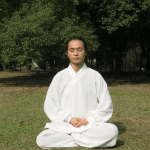Ten tips for practicing Tai Chi, which are very important for practicing Tai Chi!
1. Tai chi often does not have obvious health benefits, which may seem similar to slow walking or climbing. In fact, this is not the case.
- Insufficient Practice Time:
- Practicing only three rounds of simplified Tai Chi daily amounts to about 15 minutes, which may be suitable for some but too short for most people.
- Ideally, practitioners should aim for five to seven rounds of Tai Chi practice, with each session lasting more than half an hour.
- Some experts even advocate for an hour of practice, excluding time spent standing and chatting.
- Personal Experience:
- Determine the appropriateness of practice duration based on individual feelings.
- A satisfactory practice session should leave practitioners feeling happy and refreshed afterward.
2. The direction of improvement is not clear, and you don’t know how to work hard.
- Three Stages of Training in Tai Chi:
- Body Training (Familiarity):
- Corresponds to the first stage of familiarity in the boxing manual.
- Focuses on practicing the softness of the body to achieve a state of softness.
- Qi Training (Understanding Strength):
- Corresponds to the second stage of understanding strength in the boxing manual.
- Involves making the internal Qi full to develop internal strength.
- Spirit Training (Divine Enlightenment):
- Corresponds to the third stage of divine enlightenment in the boxing manual.
- Emphasizes training the spirit, reaching higher levels of awareness and consciousness.
- Focus of Tai Chi Practice:
- The practice of Tai Chi primarily lies between body training and Qi training.
- Body training aims to attain softness in the body, while Qi training aims to cultivate internal Qi and strength.
- Achieving internal Qi and strength leads to significant health benefits and is the primary focus of Tai Chi practice.
- Continuous Development:
- Advancing through the stages of Tai Chi practice involves experiencing various levels of softness in the body and internal Qi cultivation.
- There are numerous levels to explore and experience within the realm of Tai Chi practice, indicating an ongoing journey of development and refinement.

3. The process of practicing tai chi is a process of constantly deepening, constantly finding errors, and correcting errors.
Progression in Tai Chi Practice:
- Learning Routines:
- Start by learning a set of routines, focusing on getting the postures right.
- Ensure correct alignment of hands, eyes, body, and steps.
- Practicing Routines:
- Practice the routines according to key points:
- Lightly, slowly, roundly, and evenly.
- Aim for coordination, fluency, roundness, and coordination between upper and lower body.
- Maintain a clear distinction between virtual and real movements.
- Practice the routines according to key points:
- Deepening Understanding:
- As you delve deeper into Tai Chi practice, deepen your understanding of key points and requirements.
- Continuously identify and correct mistakes in your movements.
- Conscious Exercise:
- Consciously exercise each key point according to its requirements.
- Focus on practicing one key point intensively for a period (one or two months) before moving on to the next.
- Incorporating the Waist:
- Once movements are correct, begin focusing on using the waist.
- The waist should lead the movement of the limbs.
- Tai Chi requires the waist to initiate movement before the limbs follow suit.
4. You can experience how to use your waist from the punches with very obvious waist rotation arcs.
Utilizing the Waist in Tai Chi:
- Driving Hand Movements:
- Left and right rotations of the hands are driven by the waist.
- The hand hugging the knee turns over from in front of the knee due to waist rotation.
- Forward Movement:
- Forward prying of the hand results from the waist moving forward to pull the hand and body together.
- Practicing Punches:
- When practicing a set of punches, focus on using the waist rather than the hands.
- Previous Tai Chi practice may have been artificial if the emphasis was on the hands rather than the waist.
- Dynamic Movement:
- Using the waist ensures that strength is not solely localized in the hands.
- Understand that waist rotation is facilitated by the rotation of the hips, as the spine’s rotation is limited to maintain an upright posture.
5. Breathing
- Initial Focus on Learning Form:
- Beginners can disregard breathing and concentrate on mastering the form.
- Natural Breathing During Tai Chi:
- Tai chi’s slow and even movements naturally induce deep and prolonged breathing.
- Gradual Introduction of Breathing Practice:
- After some practice with the form, consider dedicating time to breathing exercises.
- Initially, practice breathing while remaining still, then emphasize exhalation.
- Flexible Coordination of Movements and Breathing:
- Avoid overly rigid coordination of movements and breathing, as tai chi is not primarily a breathing exercise.
- While some movements can be combined with breathing, forcing coordination may disrupt the flow of the practice.
6. Feel the meaning and the Intention of Tai Chi Chuan
- Looseness:
- Emphasizes lightness and softness in movements, allowing for flexibility and fluidity.
- Steadiness:
- Involves maintaining stability and balance, distinguishing between virtual and real movements.
- Avoids rushing or chaotic movements, ensuring a calm and controlled practice.
- Slowness:
- Facilitates silent contemplation and introspection, promoting meticulous attention to detail.
- Supports the use of imagination to enhance movements and internal focus.
- Evenness:
- Achieves a static state when the body and mind are evenly coordinated.
- Enables the full utilization of strength and power throughout the entire practice.
- Artistic Conception of Tai Chi:
- Requires mastering looseness, distinguishing between virtual and real movements, coordinating the upper and lower body, integrating internal and external aspects, and maintaining smooth breathing.

7. Relaxation
Tai chi has two requirements for the limbs: looseness and relaxation.
- Looseness:
- Defined as the softness and high flexibility of the limbs and joints.
- Emphasizes achieving a state of natural and comfortable extension in the joints.
- Considered the soul of Tai Chi, representing the essence of its practice.
- Practitioners constantly strive to attain higher levels of looseness in their movements.
- Relaxation:
- Integral to all stages of Tai Chi practice.
- Involves gradually reaching the maximum degree of looseness through thought and consciousness.
- Aimed at minimizing force and tension while maximizing flexibility and fluidity.
- Progresses from lightness to profound looseness over time.
8. When you are completely relaxed, you will feel a sense of heaviness throughout your body. This is a natural heaviness, not a forced one. It is as if your body is moving through water.
- Softness and Relaxation Development:
- Long-term practice of Tai Chi leads to increased softness and relaxation in the body.
- Practitioners experience a heightened sense of heaviness in the body and hands.
- This sensation arises from becoming more attuned to the forces of gravity and inertia.
- Development of Inner Strength:
- Inner strength in Tai Chi is primarily cultivated through practicing the form.
- Focus on sinking the shoulders and elbows to feel the weight of the arms.
- Direct Qi to the dan tian and relax the waist to feel the weight of the upper body.
- Sit the body down to enhance awareness of body weight distribution.
- Walk gracefully to feel the weight of the entire body shifting on the legs.
- Signs of Inner Strength Development:
- Each part of the body attains a sense of the body’s weight.
- Achieving this sensation indicates the development of inner strength in Tai Chi.
9. To further develop your inner strength, you can practice sinking your qi to your feet. To do this, you should focus on using the strength of your feet to propel your hips and your entire body. As you practice this, your body will become more relaxed and light, and all of your movement will come from the reaction force of your feet pushing against the ground.
Here are some specific exercises you can do to sink your qi to your feet:
- When you walk, focus on using the strength of your feet to propel yourself forward.
- When you stand, focus on keeping your weight evenly distributed between your feet.
- When you practice the form, focus on using the strength of your feet to move your hips and body.
10. To further practice releasing your qi, you should focus on the following:
In every fixed position, relax your joints and ligaments, and keep your intention far.
Use your intention to guide your qi from your feet, up through your body.
As you practice this, you will start to feel a sense of numbness and fullness in the target area, and your hands will feel as if they are about to jump. This is a sign that you are releasing your inner strength.

Summary
In summary, it is important to understand that learning a set of tai chi forms only means that you can practice on your own. It does not mean that you have already learned it. Tai chi is not just about the form. It is also about the content, which is very extensive. Only when you have the content can you say that you have the flavor of tai chi. At this point, you can say that you have basically learned it. You still need to keep practicing and make the flavor of tai chi more and more rich. If the flavor of tai chi is still wrong, then it is still a set of empty forms. You will not be able to make progress if you practice it.
If you practice tai chi every day, winter and summer, you will definitely be healthy. However, the degree of effectiveness may vary. After you have practiced tai chi for a long time, the circulation of qi and blood in your body will become normal, and you will feel a sense of lightness and comfort. Your body will be healthier, and you will be on the right track.
More to read:
What Is Ba Duan Jin? The Most Complete Tutorial For You.
What Should Qigong Beginners Know? Quick Ways To Start
Do You Know How To Meditate? The Easy Way To Do It
How To Learn Qigong? 12 Things Beginners Must Know
What is Qi Gong? How to understand it easily?


